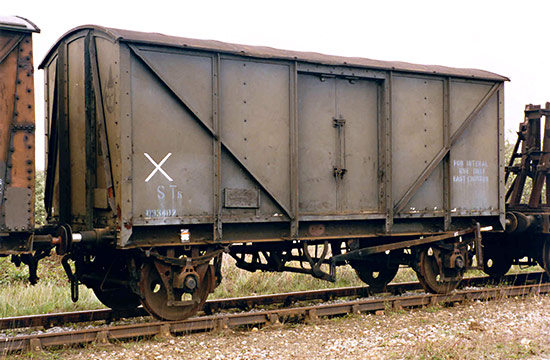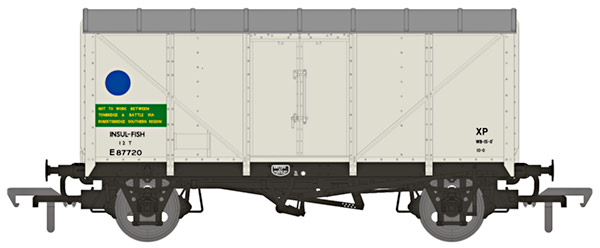Carriage & Wagon Dept -
Stock Lists: Carriages, Vans, Wagons & Multiple Units -
C&W News
SR Coach Group - Goods Division -
Operation Undercover -
Technical -
Join us
Goods Division: Home - Shop - Projects - Instagram - Flickr - Facebook - Donate


British Railways Standard 12 Ton
INSUL-FISH Insulated Fish Van No. 87720

12 Ton insulated fish van, November 2003, Richard Salmon
As Great Britain is surrounded by sea, fish has always been an important part of our diet. Fresh fish is extremely perishable and begins to rot quickly unless it is preserved by salting, pickling, smoking or freezing. The advent of the railway in the nineteenth century allowed the product to be carried quickly to remote destinations and thus new markets. By the late 1940's/early 1950's, around a million tons of fish were landed annually at British ports. 75% was carried by rail; an average of over 2000 tons having to be moved daily.
The most productive fishing grounds around Britain were in the North Sea and the bulk of the fish for the home market was landed on the east coast, so it is hardly surprising that the LNER led the field in the design of railway vehicles for the carriage of fish. Prior to WW2 they had produced a conventional 12-foot wheelbase, vacuum-braked fish van with wooden body and underframe. Some of these were either built, or retrospectively rebuilt with additional insulation and recessed twin sliding doors.
The first examples of LNER Diagram 214 (later becoming BR Diagram 800) vans appeared in 1949. They had a 15-foot wheel-base and were fitted with vacuum brakes. The body was constructed from plywood skinned with smooth aluminium sheet, making the interior easier to clean. The exterior was painted white to reflect heat. The roof was made from two skins of aluminium filled with "Ozanote" rubber insulation. The doors were draught proofed and the interior would have been kept cool by boxes of "dry ice" (solid carbon dioxide). As the fish boxes were packed with water ice, two floor drains prevented melted ice flooding the van. These vans were numbered, not as wagons but, like milk tankers, in the non-passenger coaching stock series. Although the BR standard insulated fish van, being an Eastern Region (ex-LNER) design, all the numbers were given an "E" prefix.
E75000 - E75599 were built in 1949/50 to diagram 214 (BR 800).
E87001 - E87330 were built in 1954 under Lot 30125 to BR diagram 800.
Subsequently, the body framing and door handles were redesigned and a new BR diagram, 801 was issued, three further Lots being built to this. These were equipped with roller-bearing axles for express fish workings from the Scottish and North-East ports to London, with rafts of vans being worked onto the Southern Region from Holloway Yard (ER).
E87500 - E87683 were built in 1960 under Lot 30344
E87695 - E87954 were built in 1960 under Lot 30384
E87958 - E88056 were built in 1961 under Lot 30442
The entire diagram 800/801 fleet was built at the ex-LNER Faverdale Works in Darlington, County Durham. Faverdale Works was closed in 1963.
These vans worked from the major Eastern fishing ports to all parts of the BR network. Each morning, wagons of fish left smaller ports such as Fraserburgh. They were formed into trains which left the ports of Aberdeen, Hull, Grimsby and New Clee each lunchtime for destinations including London (Kings Cross and Holloway), Banbury, Cambridge, Cardiff, Leeds and the West Riding, Leicester, Nottingham, Manchester and Plymouth. The fish travelled onwards, either by lorry or further by rail. The south-east was served by two trains from Holloway each night.
By the early 1960's, the situation had changed. Refrigeration had developed so that much fish was processed, packed and frozen in plants very close to the ports. The wet fish market declined. Landings at British ports were also declining, possibly the first signs of over-fishing? Trunk roads were improved and the first motorways built. New lorries had diesel engines in place of petrol, and could be fitted with petrol driven refrigerating plant. Road legislation changed, dramatically increasing maximum road speeds of commercial vehicles. Lorries could now carry a larger load faster and cheaper than ever before.
The volume of fish carried by rail declined. From being the most efficient carrier, it was questionable whether the railways made a profit carrying it. However, the traffic may have broken even and it was still an important volume traffic for the Eastern Region. Despite this, and the then recent heavy investment in new vehicles, the British Railways Board (under the leadership of Dr. Richard Beeching) decided to withdraw from the business in 1964.
Fresh fish was no longer carried by rail. Many of the vans were subsequently allocated to parcels traffic and some were placed in Departmental service or Internal Use as mobile stores.

The body framework identifies our example of the BR Standard 12 Ton "INSUL-FISH" as a BR diagram 801 version. All vehicles to this diagram and many to BR 800 were fitted with roller bearing wheelsets for higher speed running and the bodysides of vehicles so equipped were marked with a large blue circle, known as a "Blue Spot". It is fitted with vacuum braking and Oleo pneumatic buffers. A through steam heat pipe allowed it to travel in passenger trains. We are unsure of the exact identity of our van but believe that it may be E87720 (1960, Lot 30384) which became Internal User 083402 on the Southern Region. It appears that some published information about this vehicle's numbering is inaccurate.
Right: Internal User Van 083402, the former E87720, at Hoo Junction, 4 May 1986 (Andy Prime)
The van could probably be made serviceable fairly easily but needs its paintwork completed. It is at present in store at Horsted Keynes. It is to be hoped that it can be returned to service for Goods Train or Branch Line days at some stage in the future.
Type: Insulated Fish Van
BR Diagram: 801
Built: 1960, at Faverdale Works, Darlington - Lot No. 30384
Length: 21' 8"
Wheelbase: 15'
Brakes/heating: Vacuum and hand brakes and a through steam-heat pipe
Tare Weight: Approx 9 Tons 15 cwt
Load: 12 Tons (although a typical load of fish would be just 2 tons per vehicle)
Original No: believed to be E87720
Other Nos: 083402
Withdrawn: 1981
Preserved: c1992-95
Is it an appropriate vehicle on the Bluebell?
A frequently asked question... but yes, such vans are appropriate to this area of Sussex, since some vans regularly worked through from Kings Cross, via the Widened lines, to Victoria, where they were then dispatched attached to a suitable train, probably via the Cuckoo Line, to Eastbourne.
Recommended reading:
Blue Spot Insulfish Vans on the Blood and Custard web site.
British Railway Vans, Railways in Profile Series No.3, by G.Gamble.
Published by Cheona Publications 1997, reprinted 1998 & 1999. ISBN 1 900298 03 1
This book may be available from the Bluebell Railway's shop.
Model of our van:
 Limited edition of 100 Models, a Rapido Exclusive model, commissioned by the Bluebell Railway Goods Division in conjunction with The Wagon Yard.
Limited edition of 100 Models, a Rapido Exclusive model, commissioned by the Bluebell Railway Goods Division in conjunction with The Wagon Yard.
The model features our preserved van No. 87720 with BR Southern Region markings denoting the vehicle "Not to work between Tonbridge and Battle via Robertsbridge Southern Region".
Delivery is in Spring 2025, and may be pre-ordered via the Goods Division online shop for delivery, or (free) collection from Horsted Keynes.


Return to BRPS Home Page,
to the Timetable or to Special
Events
Goods Division: Home - Shop - Projects - Instagram - Flickr - Facebook - Donate
Carriages & Wagons -
Intro -
Development -
Stock Lists: Carriages, Vans, Wagons & Multiple Units -
Carriage Fleet Review -
Join us
C&W Works News - SR Coach Group - Goods Division -
Operation Undercover -
Carriage Shop -
Technical Pages
Visitor Info. -
Museum -
Trust -
Catering -
Contacts -
What's New -
Projects -
Locos -
Carriages & Wagons -
Signals -
History -
Other -
Links -
Search -
FAQ
Why not become a BRPS Member? -
Get more involved as a Volunteer
Your ideal Film/TV location?
 Photos © Richard Salmon and Andy Prime, text © Martin Skrzetuszewski
Photos © Richard Salmon and Andy Prime, text © Martin Skrzetuszewski
Page created by Nick Beck, 1 June 2006, and last updated by Richard Salmon, 12 March 2025
© Copyright BRPS. Privacy Policy
|











